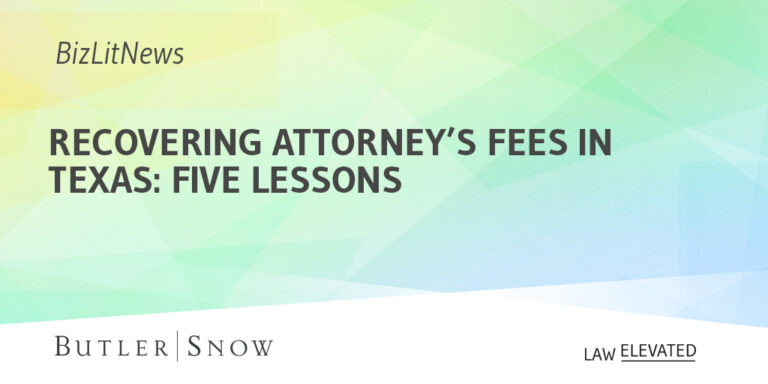February 20, 2020
Obtaining an award of attorneys’ fees might be the final step in a long-waged litigation battle but to do so successfully requires careful planning and diligence from the outset of a case. The Texas Supreme Court recently clarified the evidence required to obtain and affirm such an award. Rohrmoos Venture v. UTSW DVA Healthcare, LLP, 578 S.W.3d 469 (Tex. 2019). The Texas Supreme Court also recently confirmed that these evidentiary standards apply equally when fees are sought to be recovered as a sanction. Nath v. Texas Children’s Hosp., 576 S.W.3d 707, 710 (Tex. 2019). To best serve a client’s interests of recovering attorneys’ fees in Texas, whether as a prevailing party or as a sanction, lawyers should adhere to five lessons from Rohrmoos.
Lesson One: Confirm a legal entitlement to recover fees. “In Texas, as in the federal courts, each party must pay its own way in attorney’s fees … unless a statute or contract provides otherwise.” Rohrmoos Venture, 578 S.W.3d at 484. Certain claims, such as a breach of contract claim brought under Chapter 38 of the Texas Civil Practices and Remedies Code, entitle a prevailing party to recover attorneys’ fees. Other claims, such as a common law fraud claim, do not afford such a remedy. In establishing your initial case strategy, it is important to consider which claims will and will not allow for recovery of fees, and advise your client about the pros and cons of pursuing each claim accordingly. Also, be aware of fee-shifting procedural tools (such a motion to dismiss under the Texas Citizens Participation Act) and various Texas statutes and rules that allow for recovery of fees as a sanction (such as Civil Practice and Remedies Code Chapters 9-10, and Texas Rule of Civil Procedure 215).
Lesson Two: Keep accurate, contemporaneous billing records. Although billing records are not absolutely required to prove the amount of reasonable and necessary fees, it is “strongly encouraged” to submit such proof in support of attorneys’ fees. Rohrmoos Venture, 578 S.W.3d at 502. It is much easier to review, summarize, and testify about the work performed (often years later) if you have been diligent in your billing practices throughout. Time should be kept in a manner that demonstrates the “(1) particular services performed, (2) who performed those services, (3) approximately when those services were performed, (4) the reasonable amount of time required to perform the services, and (5) the reasonable hourly rate for each person performing the services.” Id. It is also advisable to keep time in a manner that is specific enough to cover the topic but without legalese and without so much detail that heavy redactions become necessary. Fact finders prefer to read invoices in plain English without the interruption of hidden text.
Lesson Three: Your fee agreement does not control the amount awarded. “[A] client’s agreement to a certain fee arrangement or obligation to pay a particular amount does not necessarily establish that fee as reasonable or necessary.” Id. at 488. Translation: even if you have agreed to handle the matter for a flat fee or contingency fee, you still must demonstrate that the amount of fees sought for recovery are reasonable and necessary based on the work performed and the time incurred. Regardless of the fee arrangement with your client, keeping accurate and contemporaneous billing records is important.
Lesson Four: Remember to timely designate fee experts. “Historically, claimants have proven reasonableness and necessity of attorney’s fees through an expert’s testimony—often the very attorney seeking the award.” Id. at 490. “[C]onclusory testimony devoid of any real substance will not support a fee award.” Id. at 501. Because expert testimony will be required, the attorney must remember to designate herself and any other attorney who will offer an opinion about the reasonableness and necessity of the fee amount(s) as an expert witness in compliance with the scheduling order or discovery control plan governing the case.
Lesson Five: Understand the “Texas two-step” calculation method. At step one, calculate the “base” or “lodestar” amount by multiplying the “reasonable hours worked” by a “reasonable hourly rate.” Id. at 498. This is an “objective calculation” that yields a “presumptively reasonable” amount. Id. at 497-98, 502. The determination of what is a reasonable market rate and what is a reasonable amount of time will typically include consideration of the following factors: (1) the time and labor required, (2) the novelty and difficulty of the questions involved, (3) the skill required to perform the legal service properly, (4) the fee customarily charged in the locality for similar legal services, (5) the amount involved, (6) the experience, reputation, and ability of the lawyer or lawyers performing the services, (7) whether the fee is fixed or contingent and the uncertainty of collection, and (8) the results obtained. Id. at 500. At step two, “adjust[] the base calculation up or down based on relevant considerations … [that were not] subsumed in the first step.” Id. “If a fee claimant seeks an enhancement, it must produce specific evidence showing that a higher amount is necessary to achieve a reasonable fee award.” Id. at 501. Remember that only “rare circumstances” justify such an adjustment. Id. at 502.
Following these five lessons from the outset of a case will be beneficial to the expert testifying about the amount of fees at the end of a case. More importantly, it will benefit your client’s best interest in obtaining a monetary award and being able to have that award affirmed on appeal.
